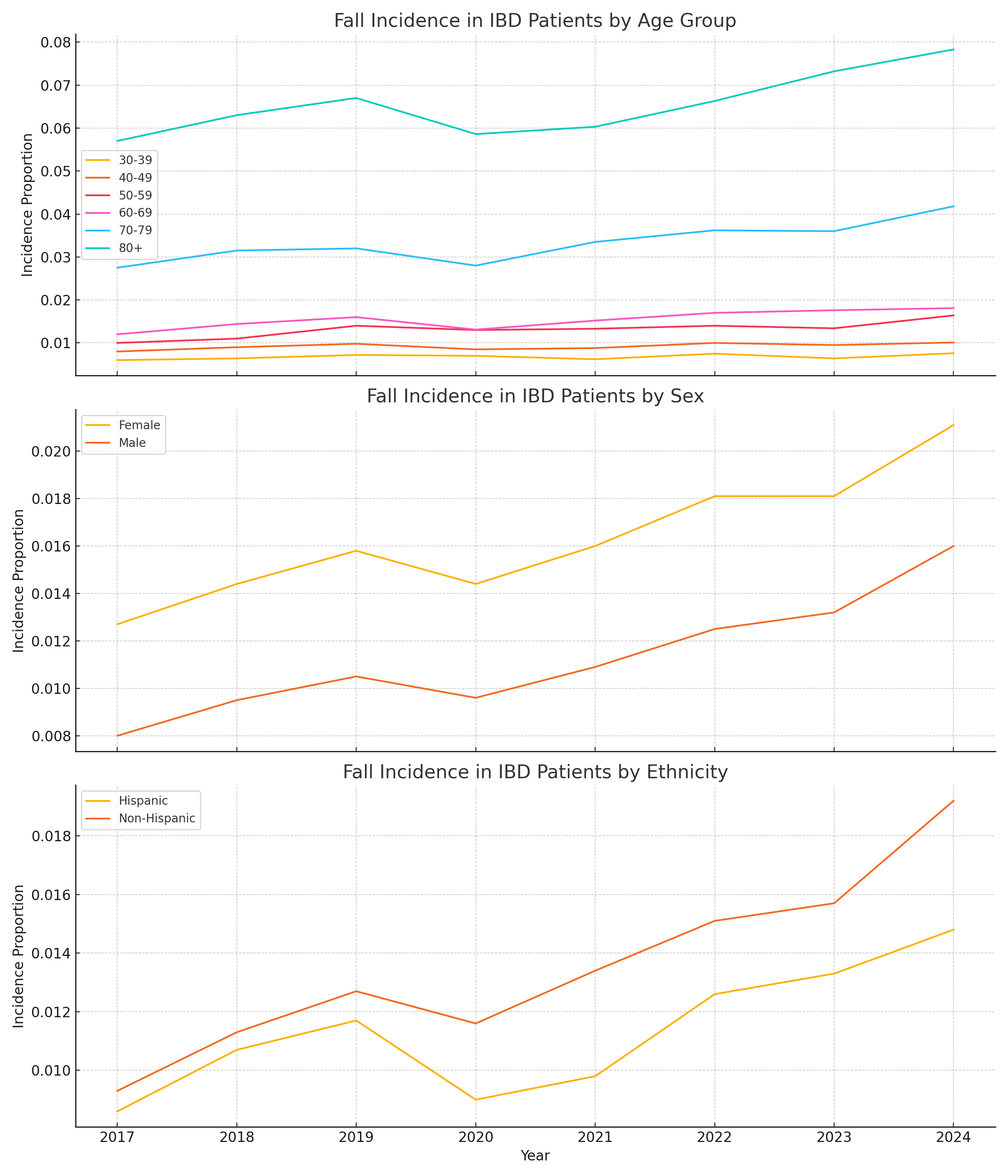Monday Poster Session
Category: IBD
P3182 - Rising Fall Incidence Among Patients With Inflammatory Bowel Disease: A Multiyear Analysis From a National Real-World Dataset
Monday, October 27, 2025
10:30 AM - 4:00 PM PDT
Location: Exhibit Hall

Ashujot K. Dang, MD
University of California Riverside School of Medicine
Riverside, CA
Presenting Author(s)
Ashujot K. Dang, MD1, Vikash Kumar, MD2, Angad Mann, MD3, Gautam Maddineni, MD4, Indu Srinivasan, MD2, Wael Youssef, MD2
1University of California Riverside School of Medicine, Riverside, CA; 2Creighton University School of Medicine, Phoenix, AZ; 3University of California Riverside School of Medicine, Rancho Cucamonga, CA; 4Florida State University, Cape Coral, FL
Introduction: Patients with inflammatory bowel disease (IBD) are more prone to falls given malnutrition, corticosteroid use, chronic inflammatory state, and frailty. However, the temporal trend and demographic patterns of fall incidence in this population remain underexplored. Our study aims to underscore the trends of falls in the IBD population, while stratifying based on age, gender, and ethnicity for a more comprehensive overview.
Methods: We queried IBD patients using ICD codes on the TriNetX US Collaborative Network and identified 718,628 adults with IBD (Crohn’s disease or ulcerative colitis) from 2017 to 2024. Fall events were identified through ICD-10 codes and analyzed for incidence and prevalence trends. Results were stratified by age, sex, and ethnicity.
Results: Between 2017 and 2024, the incidence proportion of falls in IBD patients increased from 1.1% to 1.9%. Age-stratified analysis showed the highest fall rates in adults aged ≥85 years, with incidence rising from 5.7% to 7.8%. Females consistently had higher fall incidence than males (2.1% vs. 1.6% in 2024). Non-Hispanic patients exhibited a greater increase than Hispanic patients (1.9% vs. 1.5% in 2024). The rising burden of falls in IBD was most pronounced in older adults and females across all years. It is also worth noting the decline in the incidence of falls in 2020, which was also the year of COVID, which might indicate patients being more at home in safe environments, or simply underreporting of such instances.
Discussion: The incidence of falls in IBD patients has increased steadily over the past eight years, with notable disparities by age, sex, and ethnicity. These trends underscore the need for targeted fall prevention strategies in high-risk IBD subpopulations. Further studies are indicated to dig deeper into the disparities amongst elderly, female, or non-Hispanic patient pools to improve overall patient outcomes.

Figure: Figure 1: Incidence and trends of falls based on different age groups, gender, and ethnicity
Disclosures:
Ashujot Dang indicated no relevant financial relationships.
Vikash Kumar indicated no relevant financial relationships.
Angad Mann indicated no relevant financial relationships.
Gautam Maddineni indicated no relevant financial relationships.
Indu Srinivasan indicated no relevant financial relationships.
Wael Youssef indicated no relevant financial relationships.
Ashujot K. Dang, MD1, Vikash Kumar, MD2, Angad Mann, MD3, Gautam Maddineni, MD4, Indu Srinivasan, MD2, Wael Youssef, MD2. P3182 - Rising Fall Incidence Among Patients With Inflammatory Bowel Disease: A Multiyear Analysis From a National Real-World Dataset, ACG 2025 Annual Scientific Meeting Abstracts. Phoenix, AZ: American College of Gastroenterology.
1University of California Riverside School of Medicine, Riverside, CA; 2Creighton University School of Medicine, Phoenix, AZ; 3University of California Riverside School of Medicine, Rancho Cucamonga, CA; 4Florida State University, Cape Coral, FL
Introduction: Patients with inflammatory bowel disease (IBD) are more prone to falls given malnutrition, corticosteroid use, chronic inflammatory state, and frailty. However, the temporal trend and demographic patterns of fall incidence in this population remain underexplored. Our study aims to underscore the trends of falls in the IBD population, while stratifying based on age, gender, and ethnicity for a more comprehensive overview.
Methods: We queried IBD patients using ICD codes on the TriNetX US Collaborative Network and identified 718,628 adults with IBD (Crohn’s disease or ulcerative colitis) from 2017 to 2024. Fall events were identified through ICD-10 codes and analyzed for incidence and prevalence trends. Results were stratified by age, sex, and ethnicity.
Results: Between 2017 and 2024, the incidence proportion of falls in IBD patients increased from 1.1% to 1.9%. Age-stratified analysis showed the highest fall rates in adults aged ≥85 years, with incidence rising from 5.7% to 7.8%. Females consistently had higher fall incidence than males (2.1% vs. 1.6% in 2024). Non-Hispanic patients exhibited a greater increase than Hispanic patients (1.9% vs. 1.5% in 2024). The rising burden of falls in IBD was most pronounced in older adults and females across all years. It is also worth noting the decline in the incidence of falls in 2020, which was also the year of COVID, which might indicate patients being more at home in safe environments, or simply underreporting of such instances.
Discussion: The incidence of falls in IBD patients has increased steadily over the past eight years, with notable disparities by age, sex, and ethnicity. These trends underscore the need for targeted fall prevention strategies in high-risk IBD subpopulations. Further studies are indicated to dig deeper into the disparities amongst elderly, female, or non-Hispanic patient pools to improve overall patient outcomes.

Figure: Figure 1: Incidence and trends of falls based on different age groups, gender, and ethnicity
Disclosures:
Ashujot Dang indicated no relevant financial relationships.
Vikash Kumar indicated no relevant financial relationships.
Angad Mann indicated no relevant financial relationships.
Gautam Maddineni indicated no relevant financial relationships.
Indu Srinivasan indicated no relevant financial relationships.
Wael Youssef indicated no relevant financial relationships.
Ashujot K. Dang, MD1, Vikash Kumar, MD2, Angad Mann, MD3, Gautam Maddineni, MD4, Indu Srinivasan, MD2, Wael Youssef, MD2. P3182 - Rising Fall Incidence Among Patients With Inflammatory Bowel Disease: A Multiyear Analysis From a National Real-World Dataset, ACG 2025 Annual Scientific Meeting Abstracts. Phoenix, AZ: American College of Gastroenterology.
